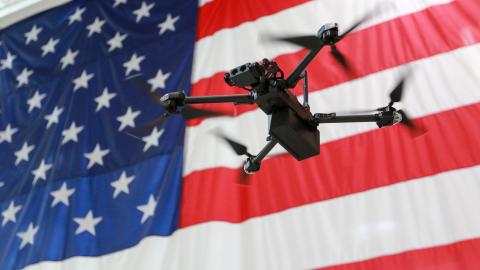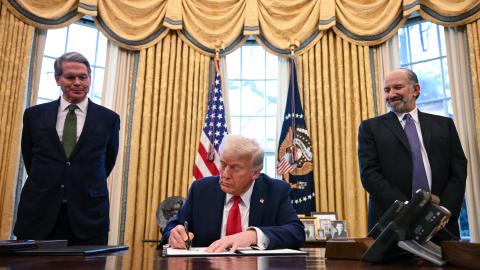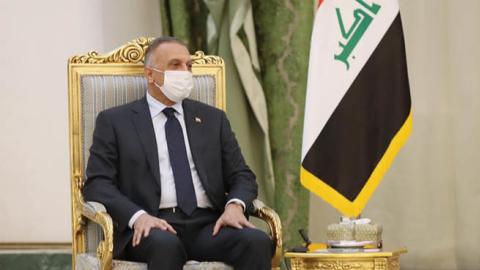Forty years ago today, Iraq launched an invasion of neighboring Iran, beginning a war that would drag on until 1988 and leave hundreds of thousands dead. This anniversary falls in the midst of what might be considered a second Iran-Iraq war, which—in stark contrast to its predecessor—has been fought in the shadows, involves political maneuvering as much as brute force, and has largely escaped the notice of the Western news media. While Baghdad launched the first Iran-Iraq war, this second one was begun by Tehran with the aim of gaining control of the Iraqi state, driving the Americans out, and securing Iranian domination of the entire region. The U.S. seems to have put its hopes in the new Iraqi prime minister, Mustafa al-Kadhimi, to help turn the tide. Whether these hopes will pan out, only time will tell.
To understand the predicament that America now faces in Iraq, it’s necessary to go back to 2003, when America took the fateful decision to oust Saddam Hussein, and to the bloody insurgency that followed. In doing so, we must set aside the still-bitter arguments about the wisdom of that decision, as well as the usual narratives found in the press, which often obscured more than they revealed.
When the U.S. and its allies entered Iraq, they knew who their enemy was: Saddam and his army. The coalition made short work of defeating the Iraqi military, but, as everyone knows, the worst was yet to come. Elite units that escaped death or capture shed their uniforms and disappeared into the population to regroup as guerrilla forces. Soon, members of the regular army joined them, convinced that, given their connections to the defeated regime, they had no future in the new Iraq the U.S. wished to create. This emerging insurgency also made common cause with Sunni jihadist groups connected to al-Qaeda, who likewise opposed America and didn’t want to see the Shiites—long repressed under Saddam—come to dominate the country. In a country of 26 million, the U.S. now faced an enemy that could hide in plain sight, one it was ill-prepared to fight. While America struggled to find its footing, Iran knew what to do, and had the perfect weapon at its disposal.
During the Iran-Iraq War of the 1980s, Tehran built up a militia of Iraqi Shiite defectors and former prisoners of war to fight against Saddam. This militia, known as the Badr Corps, proved invaluable for its ability to conduct sabotage operations and assassinations deep inside enemy territory. In 2003, amidst the chaos following the American invasion, Tehran dispatched some 10,000 Badr Corps fighters into Iraq to ensure that the country would never again threaten Iran.
Thus, while the U.S. and its allies were distracted by the Sunni insurgency, and trying to train an Iraqi military that could aid them in this fight, the Badr force began assassinating Iraqi pilots without regard for religion or ethnicity. Their goal was to make it impossible for Iraqi aircraft to bomb Iranian cities as they had in the 1980s. Badr would ensure that the only pilots taught to fly American planes would be the ones they had vetted themselves.
The assassinations were merely one tactic of a strategy based on exploiting Iraq’s sectarian divide. While precise numbers are hard to come by, Shiites make up about 58 percent of the population, and Sunnis 37 percent. (The proportion of Shiites among the Arab population is even higher.) Although Saddam Hussein’s regime and its ruling Baath party were nominally socialist and secular, their upper echelons were overwhelmingly made up of Sunni Arabs. Thus Iran, a Shiite theocracy, could take advantage of Shiite resentment in Iraq, while Sunni Iraqis without much love for Saddam still saw his fall as a loss for their own sect. Nonetheless, it was not inevitable that Iraq would come apart along sectarian lines; rather Iranian scheming and American insouciance made it do so.
The coalition forces needed help in fighting a counterinsurgency, and came to rely on those who were most willing to provide it: members of the Badr Corps’ political wing, the Supreme Council of Islamic Resistance of Iraq. They spoke English; they wore suits; and they smiled. Most importantly they were exactly what coalition forces needed: local partners who would fight alongside them against the insurgents. By cooperating so publicly with the Americans, they convinced many Sunnis that Washington was siding with Tehran—and some of these Sunnis began to see the insurgency as more appealing than the alternative.
This new relationship with Shiite leaders would lead to the welcoming of Badr militiamen into the new Iraqi military the U.S. was building, and funding to the tune of millions of dollars a year. Having assisted in purging the ranks of mostly Sunni Baathists, Badr saw that members of its militia were placed in both the rank-and-file and the officer corps, strategically taking over those units that could suit its purposes. Now Badrists in the Iraqi army could report to their masters in Iran about U.S. troop movements and activities. They also obtained positions in the civilian government, especially the defense and interior ministries.
But even as they played the role of helpful local allies to the Americans, their affiliates were killing Sunnis in Baghdad, leading to reprisals by the insurgents. At the same time, Washington found itself partnered with a new prime minister who would get the better of it for the next decade, to the benefit of Tehran and to the detriment of the Iraqi people. Nouri al-Maliki became premier in 2006 to replace the transitional government installed by Washington following Saddam’s removal. A weak and relatively unknown leader of a Shiite religious party that had aligned with Tehran during the Iran-Iraq War, Maliki was a compromise candidate. But he skillfully managed to stay in the good graces of both the U.S. and the Islamic Republic, maneuvering himself into a position of strength while solidifying Shiite militias’ control over the security service.
From the perspective of Iraqi Sunnis, the U.S. had ousted a Sunni ruler, installed a pro-Iranian Shiite in his place, and was backing attacks on their coreligionists. The Americans wouldn’t fully grasp the gravity of their mistake until 2014. But even in 2005, before Maliki was sworn into office, it was clear something was wrong.
On average, 50 zip-tied bodies of executed Sunnis would be dumped in Baghdad every evening. Soon the city would be sharply divided along sectarian lines. The extrajudicial killings of 2005 and 2006 changed its demographics; Sunni neighborhoods adjacent to Shiite ones became Shiite or mixed. While this project of religious cleansing would never get the attention later garnered by Islamic State’s made-for-TV beheadings, or its dramatic attempts to eradicate Christians and Yazidis, it was every bit as brutal. The city’s Sunni residents came to feel like second-class citizens. Worse still, Badrists in the government provided Shiite death squads with official vehicles, badges, and uniforms—making them appear as if they were operating with the imprimatur not just of the civilian government, but of the U.S.
For American forces, the priority remained the insurgency. But their efforts to fight it using predominantly Shiite forces heavily infiltrated by Iran-backed militias resulted in limited security gains while increasing popular support for the insurgents. These Shiite forces had no problem conducting aggressive military operations in Sunni areas, but had no interest in holding territory and protecting the Sunni population from al-Qaeda, let alone from Shiite militias. They saw every Sunni male between the ages of fourteen and sixty as an insurgent or collaborator, and often acted accordingly.
Only after itbecame clear that the Shiite-dominated Iraqi army could not achieve any lasting gains did the U.S. change its approach. It began reaching out to Sunnis—many former insurgents among them—who were fed up with al-Qaeda’s brutality and bloodlust. This new partnership resulted in what became known as the Sunni Awakening. Moved to help America bring some measure of tranquility to their troubled country, participants in the Awakening made for good allies, intimately familiar with the neighborhoods where insurgents were hiding, connected to local tribal leaders, and concerned about the wellbeing of the populace. In the end, those who participated in the Awakening—not the Iran-backed Shiites—helped the U.S. kill or capture the diehard rebels.
This force quickly grew to comprise more than 100,000 U.S.-vetted Sunni fighters. Besides playing a crucial role in defeating al-Qaeda in 2008, it also protected Sunni civilians from vicious attacks by the Shiite militias. Unsurprisingly, Iran and its Iraqi allies saw it as a direct threat to their hegemony.
To fight back, the pro-Iranian militias, who were quickly becoming more of a threat to the U.S. mission than al-Qaeda, accelerated their lethal attacks on American servicemen, under the direction of, and with assistance from, Iran’s Revolutionary Guard commander Qassem Suleimani and Lebanon-based Hizballah. Prime Minister Maliki, meanwhile, maintained his alliance with these militias, using them to marginalize, isolate, and intimidate his rivals. And while Sunni forces were helping to defeat the insurgency, Maliki purged the most effective Sunni officers from the army, often by charging them with supporting al-Qaeda and its affiliates. These officers frequently found themselves not just stripped of their ranks but arrested or “disappeared.” Soon the army divisions operating in Baghdad and key areas around it were transformed into de-facto extensions of Maliki’s Dawa party and Badr.
Between 2008 and the U.S. exit from Iraq in 2011, Maliki succeeded in effectively dismantling the Awakening. The absence of both the Americans and the moderate Sunni forces created a major power vacuum, one that Islamic State (IS) came rushing in to fill. When IS—built out of the remnants of al-Qaeda in Iraq—came rolling into Mosul, it was welcomed by Sunni tribal leaders and ex-Baathists, who hoped it would right the wrongs of Maliki’s sectarianism. But this new, ruthless jihadist force also systematically hunted down those Sunnis who had worked with America, labeling them “collaborators.” Without either the U.S. or the pro-American Sunni force to protect them, they were left defenseless, caught between the Shiite hammer and Islamic State anvil. IS only began to lose popular support when it started publicly executing those Sunni leaders who were initially willing to cooperate with it, but not to pledge loyalty.
With IS ascendant, the U.S. repeated the same mistake it had made a decade earlier, partnering with Shiite jihadists to fight Sunni ones, thus empowering Iran while turning potential Sunni allies into enemies. By carrying out airstrikes against IS forces fighting Shiite militias, the American planes were serving, as David Petraeus quipped, as Qassem Suleimani’s air force. Despite Washington’s demand that Prime Minister Maliki step down in 2014 as a pre-condition for aerial support, the troops on the ground were still Badrists in Iraqi army uniforms—regardless of who was prime minister. Suleimani’s militias happily took credit for every IS defeat, even as the U.S. did most of the heavy lifting.
Moreover, what started in Iraq didn’t stay there. Syria, torn apart by civil war, presented the ayatollahs with another opportunity. To prop up their ally Bashar al-Assad, Iran organized loyal militias along the same model it had used in Iraq, and supplemented them with Shiite fighters from Iraq, Lebanon, Afghanistan, and Pakistan. Hizballah, meanwhile—thanks to a decade of bungled U.S. policy—had gained supremacy over Lebanon. With the war against Islamic State, Tehran cemented its power in Iraq, making it part of the emerging “Shiite Crescent,” a land-bridge from Tehran through Baghdad, Damascus, and Beirut, with Jerusalem as the hoped-for final destination. Suleimani now had a corridor to move troops, rockets, and precision missiles into Syria to be used against Israel.
This brings us the fateful Iraqi elections of 2018, by which time Islamic State had lost most of its territory and was on the retreat. Riding on their role in the campaign against IS—a role they generously embellished—the Shiite militias created a political party known as Fatah, which emerged as the second largest party in the country. Meanwhile, the American-backed candidate and his party came in fourth in the parliamentary elections and were quickly marginalized by Maliki and Fatah, which was led by the Badr commander Hadi al-Ameri.
Under Suleimani’s tutelage, Fatah allied itself with a collection of smaller parties to form the largest voting bloc in parliament—one openly loyal to Tehran and its supreme leader. Bear in mind that to Iran, Islamic State was a threat, but America was (and remains) the Great Satan, and reducing its influence was the foremost strategic goal. It should then come as no surprise that this Iranian-controlled bloc, newly secure against Islamic State and the Sunnis, would shift its focus to driving the U.S. out of Iraq.
With control of the Iraqi political system and primacy over the security apparatus, Suleimani directed a militia rocket attack on a U.S. military base south of Kirkuk on December 27, 2019. In retaliation the U.S. carried out strikes on several militia positions along the Iraqi-Syrian border. These were the same militias, and even some of the same positions, that Israel has been attacking systematically on the Syrian side for years.
Rather than back down, Suleimani’s militias rolled into Baghdad’s protected international zone and attacked the U.S. embassy, laying siege to it for 36 hours. The Badr Corps demonstrated its influence over the government and the military by ordering the security forces—America’s supposed “partner”—to stand down during the attack. This proved to be a miscalculation: Washington responded with further airstrikes, one of which killed Suleimani. Of course, the only reason the strike on Suleimani was successful was that Washington didn’t give the Iraqi government advanced warning—otherwise, there is little reason to doubt that somebody would have tipped the Iranian generalissimo off.
Iraq’s parliament and its prime minister—Abdel Abdul Mehdi, the former member of Badr’s political wing—condemned the killing and threatened to expel American forces. Already reeling from criticism at home and abroad for his tacit support of the militias’ draconian suppression of protestors in 2019—while stubbornly denying that it was happening—Mehdi stepped down. Like Maliki before him, he was a compromise candidate who had disappointed American hopes.
Iran’s militias have obtained a controlling position in the political, military, and economic sectors. Having exchanged fatigues for suits, its commanders sat in parliament, where they could select Mehdi’s replacement. They chose a candidate approved by Hizballah’s Hassan Nasrallah and Suleimani’s successor, Ismail Qani: Mustafa al-Kadhimi, the former director of Iraqi military intelligence. In the war against IS, he had proved himself a willing and effective ally, except when it came to confronting the militias. He’d failed to warn the U.S. of the impending embassy attack or of other Iran-backed attacks about which he doubtless had some foreknowledge. And even if Kadhimi decided to try to change his tune, the same militias have placed their members in the highest echelons of his government, with access to its most highly classified information. They’d find out quickly enough.
And now? Iran and its militiasseek to destabilize the Levant, to replace America’s presence, and to attack Israel. One of their foremost goals is to move precision-guided missiles through Iraq and into Syria, where they can be aimed at Israeli cities and strategic targets. Because of the increased threat from the militias, the U.S. has redeployed its troops from al-Qaim in Iraq and al-Tanf in Syria to bases where U.S. air-defense systems can protect them from attacks. That is, protect them not from IS but from entities within the Iraqi security apparatus, forces commanded by Tehran, accommodated by Baghdad, and paid for and equipped by both. Thus, after largely defeating Islamic State, the American military is now retreating from a pro-Iranian force it worked with and helped to put into a position of political power.
The pro-Tehran militias in Iraq are operating with impunity. They pose a threat to the Iraqi people, to Israel, and to the region. Ultimately, their goal is to undermine U.S. interests. Iraq today is no better off than it was when the campaign against Islamic State began. Moreover, the very conditions that led to the rise of IS remain, and if anything they are more pronounced than they were a decade ago. The U.S. must communicate to Baghdad and Prime Minister Kadhimi that Iraq has two choices: tilt away from Iran or be treated like Iran. The Iraqi people, both Shiites and Sunnis, have already decided. The slogan heard at last year’s protests was Iraq Hurra! Iran Barra!—Iraq free and Iran out. Let’s hope American politicians will listen to them.
Read in Mosaic Magazine


















